KENTON ORCHESTRA MELLOPHONIUM SECTION noel wedder
|
|||||||||||||||||||||||||||||||||||||||||||||||||||||||||||||||||||||||
|
Kenton Orchestra purists disliked the four mellophonium's bellowy, punchy sound and felt they sounded like a gaggle of boisterous, out-of-control trumpets. Conversely, Kenton fans who were quite willing to musically follow Stan anywhere he might take them eagerly embraced the fortissimo volume levels the 4-man section was capable of reaching with little or no effort. The new section also precipitated a raucous clash of egos engineered by the trumpet section, who felt threatened by the presence of four "bastard" players biding their time until they could take over their chairs. Only Dwight Carver, a former French horn player, made it clear he was content to remain where he was and had no interest in joining what many considered 'the hardest working trumpet section in existence.' Such was not the case with the remaining three players who constantly engaged in mind games with their sister section and were quick to let it be known that just as soon as an opportunity arose they would make their move. The presence of several players waiting to leap into the trumpet section was distracting, to say the least. Before long, the trombone section also became disenfranchised from them due to their childish and blatant disregard for keeping the pitch under control, which according to lead trombonist Jiggs Whigham "sometimes varied within an octave on any given day." Prior to Whigham joining the Band, trombone section leader, Bob Fitzpatrick spent days of his precious free time during the 1960 inaugural tour working on their intonation and phrasing. He also told them that the section was now under his leadership and they would spend mornings rehearsing until he determined the section had cohesively pulled together enough for them to work on their own.
The die was cast when on the third morning of rehearsals the entire section went en masse to Stan and complained about Fitzpatrick's autocratic teaching methods, which included contorting his face as he leaped back and forth whenever they slipped around the beat, threatening to punch out Dwight Carver because he kept nodding off and screaming a litany of obscenities in English and Gaelic when they lost their concentration. They also made it clear to Stan they intended to file a grievance with the Los Angeles Musician's Union upon the Band's return to Southern California. Stan was so infuriated with this unprofessional display of childishness he refused to talk to them and for the remainder of the tour addressed them through an intermediary. However, his reaction paled in comparison to Fitzpatrick's, who being told he was to cancel all further rehearsals, went looking for Carver who had returned to his room for some much needed sleep. Fitz slipped the chamber maid two dollars to open up Carver's door; pulled his terrified ex-student swaddled in a mountain of bed clothes to the floor and began slapping him vigorously atop his head while remonstrating with him for being such an 'Android, *&^%$#! candy-ass!' Those who witnessed this confrontation of wills said it looked like a scene from a Three Stooges movie, especially when you realized how tiny Fitzpatrick was in comparison to the rutabaga-shaped Carver. Ultimately Stan found the tension existing between the three sections intolerable. It also drove him to distraction. So much so he threatened to fire the entire section and replace them with 'guys who are willing to work with the instrument, help develop it and have the vision to realize they can make musical history by creating a new sound.' Over the next three years Stan was heard to repeat this threat many times over. To no avail! As long as the rest of the Band treated them as unruly stepchildren they had decided to present themselves as an independent unit of the Orchestra and would follow their own rules of mutinous conduct. The intense and often blaring volume levels they achieved by willfully persisting in using trumpet and cornet mouthpieces in lieu of stock ones required the Band to alter its physical setup on stage and to isolate the mellophoniums to their own area 12' away from the rest of the group. It would be inappropriate to leave the impression that all of the 16 players who passed through the section from 1960-1963 were graduates of the 'hit-or-miss school of music.' More than a few were determined to make the section cohesive and went to the Nth degree to peacefully integrate themselves within the rest of the Orchestra. Unfortunately, for whatever reason, the nights they got it right were few and far between. In all fairness to the mellophonium players it should be noted that even the Kenton arranging staff initially had a difficult time scoring for the section.
Before
the 1960
tour began Johnny Richards, Bill Holman and
Tony Scodwell, one of the last mellophonists to play lead on the Band said, "the basic make-up of the section was a French horn type of approach where four horns were used in unison or voiced, or there were two up and two down. That was the way Johnny Richards wrote for them. Lennie Niehaus, on the other hand, voiced the parts four-ways most of the time. Stan voiced the parts with a lot of unisons like Richards, but he would occasionally write four-part harmony as well." Most people are unaware that Stan and Johnny Richards were initially responsible for designing the mellophonium which was ultimately used on the band; not the Conn Instrument Corporation! It happened while they were conducting a Stan Kenton Band Clinic at Indiana University in the summer of 1960. Stan told Johnny he was restless with the sound the Band was making. That he wished to augment their mainstream instrumentation with something new. Something unique. Something that wouldn't alter the sound, but complement it. During an earlier conversation with composer/arranger Gene Roland, Gene suggested using ten trumpets; five B-flat, five E-flat. However the big trumpets flattened-out the famous brass section work and sounded too much like trombones. Next step was to add five flugelhorns. However, they didn't project a broad enough sound and were quickly put aside. So much for using standard instruments! It seemed an impasse had been reached until late one evening Stan and Richards were returning to the University from a rather festive, liquid-fueled dinner. As they passed the music room a 'what if' glance passed between them. They stopped, went in, grabbed one of the standard mellophones used by the Indiana Marching Band and took it back to their room. After blowing a few scales into the instrument (both were journeyman trumpet players) they put the instrument aside frustrated that the mellophone fell far short of their expectations. According to Richards, "Stan suddenly got this crazed look on his face and told me to follow him. He began walking briskly down the hallway with me huffing and puffing several feet behind. As we reached the end of the hallway he stopped in front of a janitor's supply closet, opened up the door, pulled a hacksaw down from the shelf, turned and said: 'C'mon. This will do it!' "Once I saw the hacksaw I swiftly put two-and-two together and followed him into the bathroom. As I cradled the mellophone across the edge of the tub Stan began vigorously sawing down each one of the valve stems. After much sawing, swearing and bruised fingers, compounded by blowing our brains out trying to resolve the pitch and tone which woke-up half the University at three in the morning, we had a new instrument: a 'Stan Kenton-designed mellophonium.'
"Next morning we gave our
creation to one of the Conn Instrument clinicians, who
"Without missing a beat we turned the instrument over to Gene Roland who was a far better horn player than either Stan or myself. After Gene ran down several bars of Erroll Garner's 'Misty' it didn't take long for everyone gathered around him on that auspicious day to realize something magical had happened. We knew, then and there, we were off on another Kenton musical adventure. Where it would take us nobody knew. We just wanted to get started. "Moments later Stan assigned myself, Gene and Bill Holman to begin writing a battery of new scores built around the instrument. Simultaneously, Conn lost no time in handcrafting four more prototypes; four were used on the road; the fifth was taken along as a back-up. "Over the next 32-months we managed to create a wealth of new excitement for the Orchestra, along with initiating one helluva lot of controversy. You either loved the new mellophonium sound or dismissed it as a noble experiment gone awry. Only history will note whether we were successful." |
|||||||||||||||||||||||||||||||||||||||||||||||||||||||||||||||||||||||
|
'The Middle Horn Leader' May
Scooter Pirtle's in-depth and extremely informative article regarding the 1960-1963 Mellophonium Orchestras is clearly the best researched, most objective and definitive piece ever produced about the controversial instrument and the men who played them. |
|||||||||||||||||||||||||||||||||||||||||||||||||||||||||||||||||||||||
|
Possibly the most interesting chapter in the history of the mellophone occurred with the Stan Kenton Orchestra during the early 1960s. From September 1960 through November 1963, the Orchestra prominently featured a four-man section of mellophoniums and forever changed the use of the instrument. Stan Kenton started his band in 1941. Through the 1970s, the Kenton Orchestra had witnessed a lot of changes in music and in the world that listened to it. Driven by Kenton's eagerness to push the musical envelope, the band continually changed to meet, and often surpass, the demands of his loyal, but often fickle audiences.
From 1941 through the 1950s, audiences had seen Kenton's group develop from a small dance band to a full-blown orchestra. Except for a few occasions, such as featuring an electric upright bass in 1941, Kenton used the same mainstream instrumentation that was used by almost every other big band. The Kenton Orchestra's uniqueness, instead, was manifested in its arrangements. However, in the summer of 1960, Kenton found himself "restless with the sound the band was making," and he was ONCE AGAIN ready for a major change of format. Kenton solicited the help of his longtime arranger Johnny Richards to 'work over' the instrument in the Band. Kenton explained the situation to author Dr. William F. Lee this way: "The moment you heard them on record or heard them at a concert or dance, you could identify they were emanating from a low trumpet or a high trombone. We experimented with some German horns; we worked with alto trumpets; we worked with flugelhorn, nothing worked like the mellophoniums!." Gene Roland soon became involved with the search for a new instrument for the Band. Roland was a noted jazz C.G.Conn, Ltd. performer who, during his long tenure with the band played trumpet, trombone and solo saxophone. His first suggestion to Kenton was for a section of E-flat and B-flat trumpets and he even got a section of them together for Stan to hear. However, the big trumpets sounded too much like the trombones to be effectively used in the Band. The Band need something completely different. THE SUGGESTION
The Conn company primarily produced band instruments and introduced a new version of its mellophone in 1957. The instrument, was a standard mellophone except it utilized a 'bell-front' design as opposed to the traditional 'wrapped' configuration of the French horn. This was a radical, but not a new concept in the further design of the mellophone. Other companies and individuals had already produced instruments of this type prior to Conn's attempt. Conn had devised this instrument as an alternative for the French horn and its sister mellophone in marching bands. Its ability to project sound effectively and it design for outdoor playing made it quite useful for marching bands.
An exhaustive
publicity campaign was undertaken by C.G.Conn, Ltd.
Needless to say, when C.G. Conn, Ltd. heard of Stan's interest in 1960, they were quick to co-operate with him in re-configuring the instrument to accommodate his vision as to how the horn should sound to fit the needs of the Band. "Once production and testing was completed, Johnny Richards and I had them send some instruments to us. We started getting fellows to play them and both of us became excited with the sound of our newly-inspired mellophonium. It certainly had an identity of its own." Richards was certainly familiar with the mellophone family and had even used mellophonist Don Elliot on recording sessions for the 'Johnny Richards Orchestra' on January 23, 1953 and a year later on February 9, 1954. Nonetheless, Kenton was concerned about finding musicians to play such a unique instrument. "To tell them, 'you know, you could make a good mellophonium player if you tried,' they could have cared less. Only a very few had enough vision to see the future or were interested in the development of a new brass ensemble and solo sound." During experimentation sessions involving the entire 19-piece Orchestra, with Gene Roland playing solo on the lone mellophonium, the trombone section became very displeased with the addition of the instrument. Once they learned that they could probably expect three more of them very soon, several members of the Band decided to end their relationship with the Kenton organization. News of the mutiny traveled quickly and unsigned anonymous letters were sent from Kenton's office informing nine of the players that their services "would not be needed on the upcoming tour." Just before he died Bob Fitzpatrick revealed that he was convinced the letters had come from Jim Amlotte, the Band's Road Manager at the time. However, Stan soon learned of the correspondence and immediately followed up with a letter of his own expressing his desire to keep each of the members in the band. Confident with his decision to adopt the mellophonium, Kenton had Richards and Roland score a completely new concert and dance book. It was a very wise decision considering Richards' previous experience arranging for the instrument and Roland's ability to arrange for, as well as performing with the mellophonium. It was agreed that a four-man mellophonium section would be used in an alto register, acoustically nestled between the trumpets and trombones, bridging the channel of sound that lay between the brasses and the saxes.
The first section of mellophoniums featured four trumpet players. Gene Roland, Joe Burnett, Bill Horan and Tom Wirtel. The section was formed primarily for the first recording session to feature the charts of Richards and Roland. This session occurred on September 19-21, 1960 at the Capitol Studios in Hollywood. Eight charts were recorded during the three day session, most of which were never used. Several weeks later the Band went on the road with only one mellophonium player, Gene Roland. It was a joint tour with the Count Basie Band. After the tour, and for the next three years, the Band featured a four-person mellophonium section. The 'Mellophonium Band,' as it became known, featured the mellophoniums as Kenton's shining centerpiece for his 'New Era In Modern Music.' However, the 'New Era' probably sounded like the 'same old song' for the well-traveled ensemble. Between October 1960 and December 1963, the Band was on the road for nine months, traveling up to one hundred thousand miles each year. No less than sixteen people were part of the four-man section during this period.
Although Carver was treated as an outcast in the Band, he gained the respect of Kenton while on tour in New York when members of the Kenton Orchestra met several members of a musical ensemble from the Soviet Union. When the Soviets realized they were in the presence of the famous Stan Kenton Orchestra they began asking, in broken English, to meet Maynard Ferguson -- who was no longer with the band. Undaunted, Carver began explaining this fact to the Soviets in their native language. Carver also began translating conversations between Stan and the Soviet orchestra members. Apparently Carver had been using 'flash cards' to teach himself Russian during the long bus trips between performances. While Carver may have enjoyed playing the mellophonium it was no secret that many of the mellophonium players wielded their instruments reluctantly. Instead, these players were waiting for an opening in the much acclaimed and respected Samurai warrior Kenton Orchestra trumpet section. Many of these players were encouraged to 'pay their dues' in the mellophonium section in order to 'move up' to the trumpet section. However, only Keith LaMotte was able to make this transition, partly because it wasn't easy finding alternate musicians willing to play the mellophonium.
While in Chicago on tour with Kenton, Starling and bass saxophonist Joel Kaye visited the Olds Instrument factory to test some new equipment. After evaluating some new saxophones, Kaye looked around for Starling and found him in one of the laboratories, surrounded by technicians. Starling was playing one of their bell front mellophones with his back to a state-of-the-art strobe tuner, demonstrating some of the design flaws of their instrument. The technicians couldn't believe it when he would play the horn's open tone series, without corrections, to show the instrument's intonation problems, then play it with the proper corrections and center each note perfectly on the tuner -- without looking! Starling gained his accurate pitch center from his days as a piano tuner. Starling continued to play mellophonium with the Johnny Richards' Orchestra after leaving Kenton. In fact, Starling played solo mellophonium with the 'Manhattan Brass Ensemble' at Johnny Richards' funeral in 1968.
Dalton Smith probably summed up the band's opinion of the mellophoniums when he jokingly gave the newly arriving mellophonium player Jim Knight some advice in the summer of 1962: "There are great guys on the Band, but if they treat you badly, it's not because of you personally, it's because you play the damn mellophonium."
As new players entered the mellophonium section, they were usually shocked by the mellophonium's large bore (.501) and 'sluggish' response compared to the trumpet. Often helpful advice provided to them by the veteran members included tips like: "Keep the bell straight ahead and do your best on the intonation." A task wrought with considerable difficulty considering the size of the bell and the great distance of the bell from the player. Especially when the player is so far in front of the percussionist.
The mellophoniums were no more loved by the trombone section, who took the inclusion of the 'bastard instrument' in the band as an intrusion on the trombone section's trademark sound. The mellophonium players retaliated by practicing. While the rest of the band would sleep-in on the morning following a performance, the mellophonium section would rehearse. Eventually, the work paid off and, according to Kenton bassist John Worster, the section began "playing the hell out of those things." Consequently, the intense, often obscene volume levels achieved by the mellophoniums forced the Band to physically reconfigure its set-up to isolate the section. "Nobody wanted us near them," commented Keith LaMotte at a panel discussion in 1991. "We were twelve feet away from the band and they were back in the traditional three-row setup."
Although he played trumpet with the band, Stamm could occasionally be seen playing a mellophonium during band breaks. After playing a mellophonium during a break at one of the summer 'band camps' conducted by the orchestra, Stamm received curious notice from Doug Hughes (one of the young attendees who, to this day, still plays a mellophonium. "Whenever Marvin Stamm played around with the mellophonium the sounds coming out of it were awesome! While Stamm's opinion of the mellophonium itself is not known, his opinion of its use has been documented in the pages of Jazz Journal International: "I didn't like that Orchestra, because the mellophoniums were never played as the Instruments they were. I felt they were just played as loud trumpets, bombastic and bellowing, and whatever characteristics they had of charm and musicality were lost. Occasionally on a ballad they would achieve this but on the up-tunes It was just four guys blowing their brains out on an instrument that was terrible. Had it [the mellophonium] been developed and Improved upon and players came along who actually wanted to play the instrument because they liked it, things might have been different. But for the most part they were trumpet players who doubled, rather than mellophonium players." Trombonist Jiggs Whigham's contempt for the mellophoniums also made the pages of Jazz Journal International: "I was in the '63 Band, the Mellophonium Band, and the most difficult thing I had to do playing first trombones in that Band was to try to estimate where the pitch was going to be with the mellophoniums. It varied within roughly an octave on any given day!" Of all the documented causes of dislike generated by the mellophoniums, one particularly important one has been virtually overlooked -- the issue of 'space.' Adding four players to a 'one-bus band' required additional sacrifice from the band members. Seats were made available to the mellophonium players, but there was no room for their instruments in the vehicle's storage area. As a result, the mellophonium cases became a fixture in the bus aisle, symbolically in everyone's way. However, these cases provided convenient seating for the marathon poker games that became one of the most publicized aspects of the Kenton Band. This immediate "accessibility" also made the instruments prime targets for terrorism from the trombone section. Jiggs Whigam: "One time we played an NCO club at some air base in Georgia, and we got there early about four in the afternoon, and they had a happy hour. So the band hit the happy hour and a few of us got kinda happy. They had a swimming pool there, so we went to the Band bus and got the mellophoniums out of their cases and throw all four of them into the swimming pool. It was great to see these things burble down to the bottom. Stan came by and he wasn't pleased. We had to drain them all out, trying to get all the water out of all the plumbing. It took a long time twisting the things around."
The mellophonium players, however, did eventually enjoy revenge during a performance following a visit by the section to a local music store. During this visit, the players discovered that standard cornet mouthpieces fit the mellophoniums. Carl Saunders continues: "Unlike the mellophonium mouthpieces, the cornet mouthpiece had some shallowness to it so you could play high notes. So we bought cornet mouthpieces for all four mellophoniums. Now when we stood up to play solos, we could shriek like elephants! Stan looked at us as if to ask Where did those guys get those chops all of the sudden?" We're all trumpet players anyway, so now we got to lay some high notes on the trumpets players. Finally, after a couple of days, Stan came over and looked at the horns and saw the mouthpieces. He was 'hip' to us and he busted us.
He said, "put those god damn stock mouthpieces back in, I want that French horn sound!"
To say the range of music recorded by the Mellophonium Band was diverse would be a woeful understatement. The recordings, making-up over 11 albums from October 1960 through December 1963, ranged from the ridiculous to the sublime.
The most publicly acclaimed recordings were in the form of two albums . . . music from the Broadway show 'West Side Story', arranged by Johnny Richards, and his original compositions for an album entitled 'Adventures In Time' which featured unusual time signatures seldom attempted by large ensembles prior to 1963.
'Adventures In Time' received a Grammy Award and deserved critical acclaim. The album featured prominent solo work from Ray Starling and was the Mellophonium Band's most daring achievement.
Other projects were not as successful. On March 26, 29 and 30, 1962, a down-sized Kenton Band recorded an album with cowboy singer Tex Ritter.
Stan saw it as an opportunity to end the 'bigotry' in music by merging country music and jazz. The ensemble, which prominently featured the four mellophoniums, recorded numerous country & western standards including: 'Home On the Range,' 'Red River Valley,' 'Cool Water,' 'Empty Saddles' and 'High Noon.'
'Curiously, following the miserable public reaction to the Kenton/Ritter album, Stan followed up with another album one month later featuring another singer. However, this time the singer was vocalist Jean Turner and the music was primarily ballads.
. Combined with Turner's lyrical vocal abilities (sometimes eerily similar to Billie Holiday), the album was the most flawless of the entire Mellophonium Band period. Unfortunately it was the last studio recording to feature the four instruments.
Many of the Mellophonium Band's last concerts were recorded without Stan's authorization and are still circulating among Kenton fanatics to this day. These recordings include special scorings of the Kenton 'standards' that existed prior to the mellophoniums. Works like Johnny Richards' 'Cuban Fire Suite,' as well as crowd favorites such as 'Eager Beaver,' 'Peanut Vendor' and 'Intermission Riff' also weathered the addition of the mellophoniums quite well. The Kenton Orchestra embarked on a sixteen day tour to England in November 1963. Contrary to previous published accounts of the tour, it was considered to be quite successful by the participants. "Sure it was unorganized, there were double bookings and the accommodations were awful, but that was a normal tour", remarked Tony Scodwell,"The England tour was a resounding success." Mellophonium player Robert S. Crull also remembered the tour this way. "The Band was received thunderously -- the British went bananas about Stan and the Band."
Bootleg recordings of some of
the concerts, including performances in Manchester,
Between sessions at the performance at Royal Albert Hall in London, Band members were alerted to the fact that President Kennedy had been shot in Dallas. Although the details available to the British press were sketchy, Band members were left with the impression that the American government was being overthrown. The Band performed the second set after Kenton assured the audience that "He, (Kennedy), would have wanted it that way." However, the next day's performance was canceled in respect for the slain president. The assassination cast a somber mood over the Orchestra that lasted throughout the final strains of 'Artistry In Rhythm' at the close of the Mellophonium Band's last public performance on the evening of November 30 at the Bournemouth Winter Gardens in London.
The tour concluded with a pre-Christmas dinner for the Orchestra members in London. Some of the members made a vacation out of it by bringing their families along. The members knew that no future tours were scheduled for the Orchestra for at least one year. For all practical purposes, it appeared to be the end of the touring Kenton Orchestra
. Although the large ensemble was a definite financial burden on Kenton, it wasn't money that led to the demise of the mellophonium sound That honor belonged to a Los Angeles Municipal Judge. Following his divorce from vocalist Ann Richards the judge curtly informed Stan he would lose custody of their two children if he didn't stay off the road for at least one year. Following the tour the band returned to the United States. The four Conn mellophoniums, still the property of C.G. Conn, Ltd., were returned to their facility in Elkhart, Indiana and immediately were tucked away in one of the numerous storage rooms in the large facility. The whereabouts of the instruments are still unknown and there are many myths about their location. More than likely, they became victims of the closing of the C. G. Conn facility. In order to smoothly facilitate the corporation's move to Texas, many 'one-of-a-kind' prototype instruments and priceless examples of the instrument maker's art (including the Kenton Orchestra mellophoniums) housed in the brass instrument museum were whisked to local dumps and buried. The Kenton Orchestra did tour again, but without the mellophoniums. Attempts continued to revive the mellophoniums in the Kenton organization even into the 1970s. Hank Levy and former Kenton trombonist Bob Curnow repeatedly encouraged Stan to once again include the mellophoniums in the ensemble. However, a very tired and ailing Kenton was, understandably, unwilling to incur further financial burdens. The Kenton Orchestra remained a very active ensemble until Stan's untimely death on August 25, 1979 at age 67. Today there are occasional performances by 'tribute' ensembles, featuring the music of the Mellophonium Era. Often, however, these ensembles include French horn players on the mellophonium parts. Although the mellophone was virtually eliminated from the jazz world by the late 1960s, replaced by the less temperamental flugelhorn, legions of mellophone players began to appear in marching bands and competitive drum and bugle corps across the world. All due to the famous, or infamous, Stan Kenton Orchestra mellophonium section.
|
|||||||||||||||||||||||||||||||||||||||||||||||||||||||||||||||||||||||
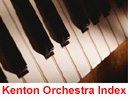 |
|||||||||||||||||||||||||||||||||||||||||||||||||||||||||||||||||||||||


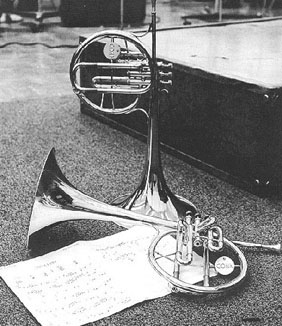 From its inception in
September, 1960 to its final appearance following a tour of England in
late 1963, the mellophonium section was constantly embroiled in
controversy.
From its inception in
September, 1960 to its final appearance following a tour of England in
late 1963, the mellophonium section was constantly embroiled in
controversy. 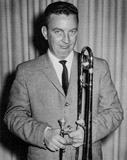 When it
came to
producing the famous Kenton brass sounds Fitzpatrick was noted for
being
very straight ahead and intolerant of any slacking off. Martinet,
though
he was, Fitzpatrick was a very able teacher and in minutes could smooth
out any problem that had caused a player to begin drifting off center.
Little did he realize he was about to run into a stone wall 40-feet
high.
Those who were there said his fleeting, educative relationship with the
mellophonium section was akin to Mohammed meeting the mountain.
When it
came to
producing the famous Kenton brass sounds Fitzpatrick was noted for
being
very straight ahead and intolerant of any slacking off. Martinet,
though
he was, Fitzpatrick was a very able teacher and in minutes could smooth
out any problem that had caused a player to begin drifting off center.
Little did he realize he was about to run into a stone wall 40-feet
high.
Those who were there said his fleeting, educative relationship with the
mellophonium section was akin to Mohammed meeting the mountain.
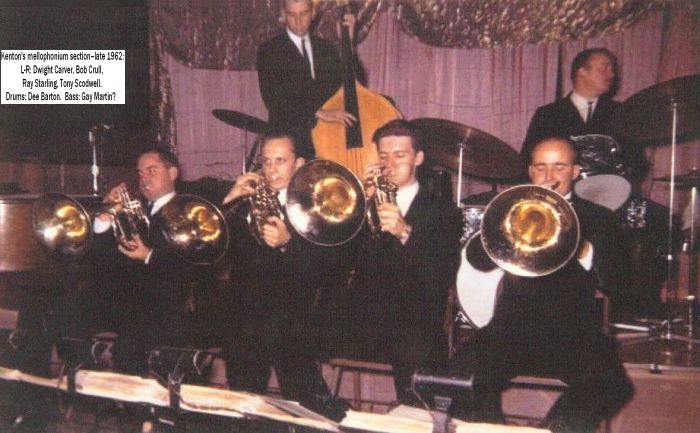 Gene Roland contributed
scores
for a 'mellophonium album' which was aborted following three days of
recording
at Capitol Records because it was impossible to definitively isolate
the
mellophonium color patterns. Even to a trained ear there was little
or
no differentiation between the mellophonium and trumpet parts during
the
ensemble work since the arrangers had yet to grasp how to write for the
section. Thanks to several scores Stan had already completed for a
yet-to-be-recorded
album entitled, 'The Romantic Approach of Stan Kenton,' Richards,
Holman
and Roland were quickly able to analyze what he had written and applied
many of his constructions to re-orchestra the mellophonium sound to his
vision.
Gene Roland contributed
scores
for a 'mellophonium album' which was aborted following three days of
recording
at Capitol Records because it was impossible to definitively isolate
the
mellophonium color patterns. Even to a trained ear there was little
or
no differentiation between the mellophonium and trumpet parts during
the
ensemble work since the arrangers had yet to grasp how to write for the
section. Thanks to several scores Stan had already completed for a
yet-to-be-recorded
album entitled, 'The Romantic Approach of Stan Kenton,' Richards,
Holman
and Roland were quickly able to analyze what he had written and applied
many of his constructions to re-orchestra the mellophonium sound to his
vision.  was also
attending the week-long band clinic and urged him to have Conn's R&D
department work-up a prototype. Several weeks later he caught up with
us in Los Angeles and handed Stan the most beautiful instrument I had
seen in decades.
was also
attending the week-long band clinic and urged him to have Conn's R&D
department work-up a prototype. Several weeks later he caught up with
us in Los Angeles and handed Stan the most beautiful instrument I had
seen in decades. 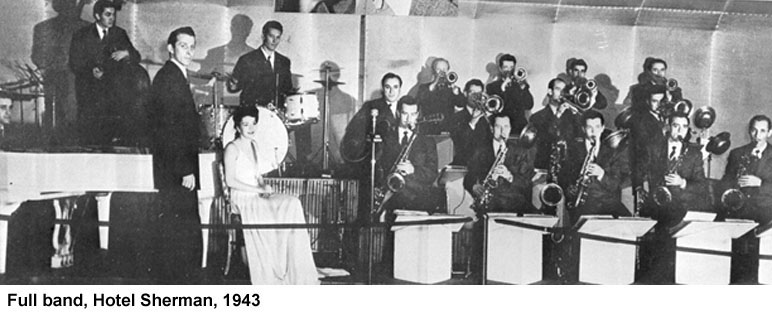
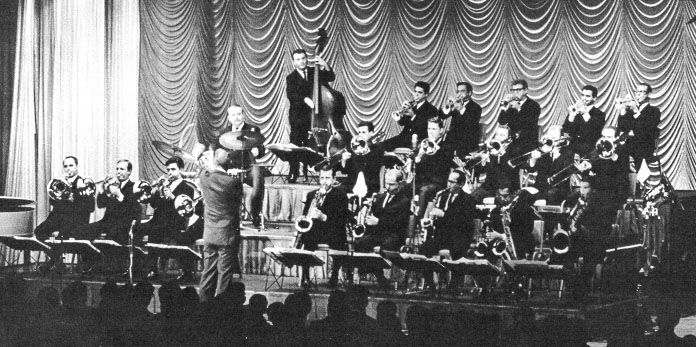
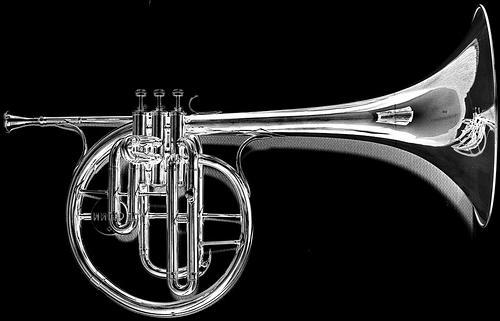 C.G.Conn, Ltd. was an American
firm of instrument manufacturers named after Charles Gerard Conn. Conn
was a cornet player whose success in the development of a
'rubber-rimmed' mouthpiece in 1875 propelled him into the instrument
making industry.
C.G.Conn, Ltd. was an American
firm of instrument manufacturers named after Charles Gerard Conn. Conn
was a cornet player whose success in the development of a
'rubber-rimmed' mouthpiece in 1875 propelled him into the instrument
making industry.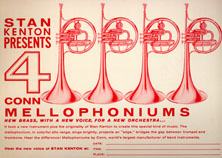 to introduce the
instrument to the public. Its first national appearance occurred on
the Lawrence Welk Show. Mellophonist Don Elliott also performed with
the newly-designed Conn mellophone on the nationally broadcast 'Steve Allen Show'
during the Summer of 1957. The instrument even spent a week on the
'Captain Kangaroo Show', along with other instruments from Conn's
antique instrument museum that was housed at the Elkhart, Indiana
facility.
to introduce the
instrument to the public. Its first national appearance occurred on
the Lawrence Welk Show. Mellophonist Don Elliott also performed with
the newly-designed Conn mellophone on the nationally broadcast 'Steve Allen Show'
during the Summer of 1957. The instrument even spent a week on the
'Captain Kangaroo Show', along with other instruments from Conn's
antique instrument museum that was housed at the Elkhart, Indiana
facility.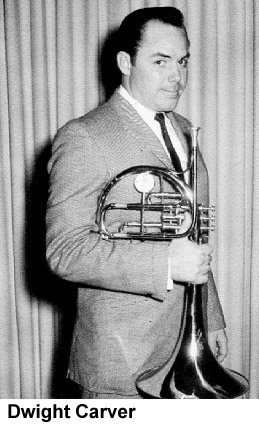 Dwight
Carver was involved with each phase of the mellophonium section's
development and was regarded as one of the few people who actually
liked playing the instrument. Classically trained Carver used a French horn mouthpiece with
his horn to achieve a dark, mahogany-rich sound which was effectively utilized on
all the lead parts.
Dwight
Carver was involved with each phase of the mellophonium section's
development and was regarded as one of the few people who actually
liked playing the instrument. Classically trained Carver used a French horn mouthpiece with
his horn to achieve a dark, mahogany-rich sound which was effectively utilized on
all the lead parts. Ray
Starling was probably the most well-known mellophonium soloist,
besides Gene Roland. Starling, a native of London, England, was a pianist and
trumpet player who had played the mellophone in Sal Salvadors' band
before being invited to join Kenton. He even owned his own mellophone.
Ray
Starling was probably the most well-known mellophonium soloist,
besides Gene Roland. Starling, a native of London, England, was a pianist and
trumpet player who had played the mellophone in Sal Salvadors' band
before being invited to join Kenton. He even owned his own mellophone.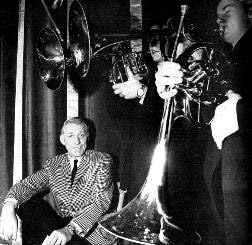 The addition of the
mellophoniums to the Orchestra made the loudest of the big bands even
louder. The new section also triggered a 'colossal battle of egos in
the band.' The trumpets were obviously distracted by the presence of
four players waiting for an opening in the trumpet section. Combined
with the ferocious volume levels dealt by the early mellophonium
sections, the hardest working trumpet section in music was forced to
work a little harder.
The addition of the
mellophoniums to the Orchestra made the loudest of the big bands even
louder. The new section also triggered a 'colossal battle of egos in
the band.' The trumpets were obviously distracted by the presence of
four players waiting for an opening in the trumpet section. Combined
with the ferocious volume levels dealt by the early mellophonium
sections, the hardest working trumpet section in music was forced to
work a little harder.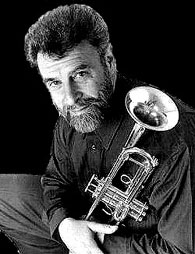 Trumpet player Marvin Stamm
was invited to join the Kenton Orchestra while still a student at North
Texas State University. After a brief stint with the band, he completed
his degree and rejoined the mellophonium band and served as a jazz
soloist in the trumpet section.
Trumpet player Marvin Stamm
was invited to join the Kenton Orchestra while still a student at North
Texas State University. After a brief stint with the band, he completed
his degree and rejoined the mellophonium band and served as a jazz
soloist in the trumpet section.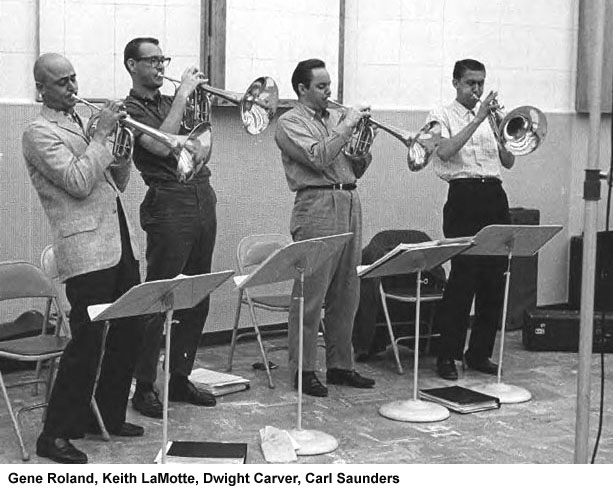 The mellophoniums had matured into an
extremely tight section after many miles on the road and many hours in the
studio. Mouthpiece adjustments also darkened the horns and solved numerous
intonation problems. Combined with some carefully scored arrangements (by
Kenton, Lennie Niehaus and Bill Holman), the mellophonium had finally
synthesized with one of Kenton's greatest big-band ensembles
The mellophoniums had matured into an
extremely tight section after many miles on the road and many hours in the
studio. Mouthpiece adjustments also darkened the horns and solved numerous
intonation problems. Combined with some carefully scored arrangements (by
Kenton, Lennie Niehaus and Bill Holman), the mellophonium had finally
synthesized with one of Kenton's greatest big-band ensembles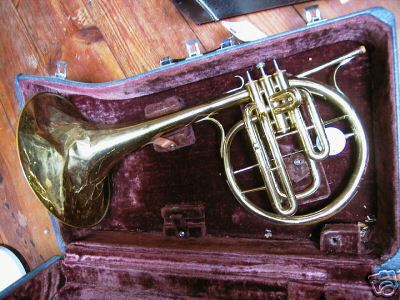 and a 'live' album
recorded in Birmingham, seem to attest to this fact. The audiences were
very receptive to the diverse collection of music presented to them.
and a 'live' album
recorded in Birmingham, seem to attest to this fact. The audiences were
very receptive to the diverse collection of music presented to them.